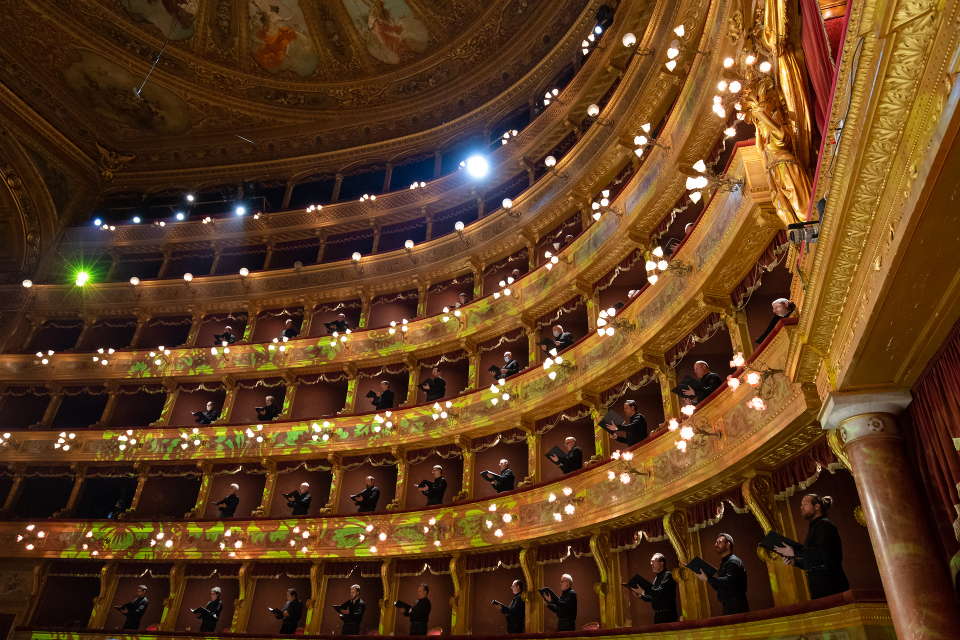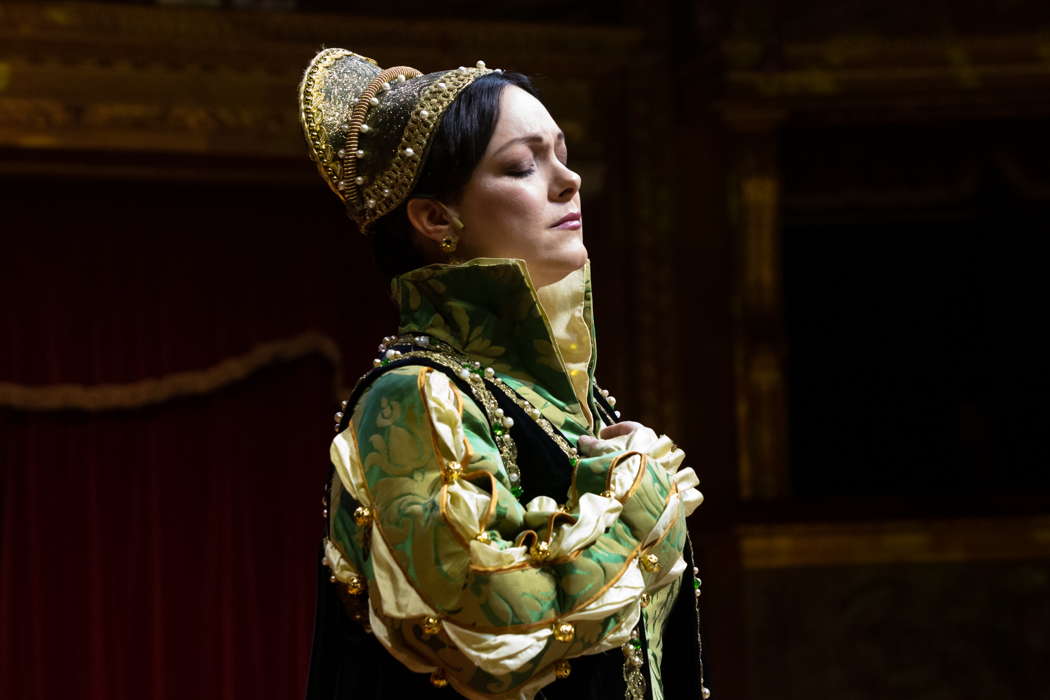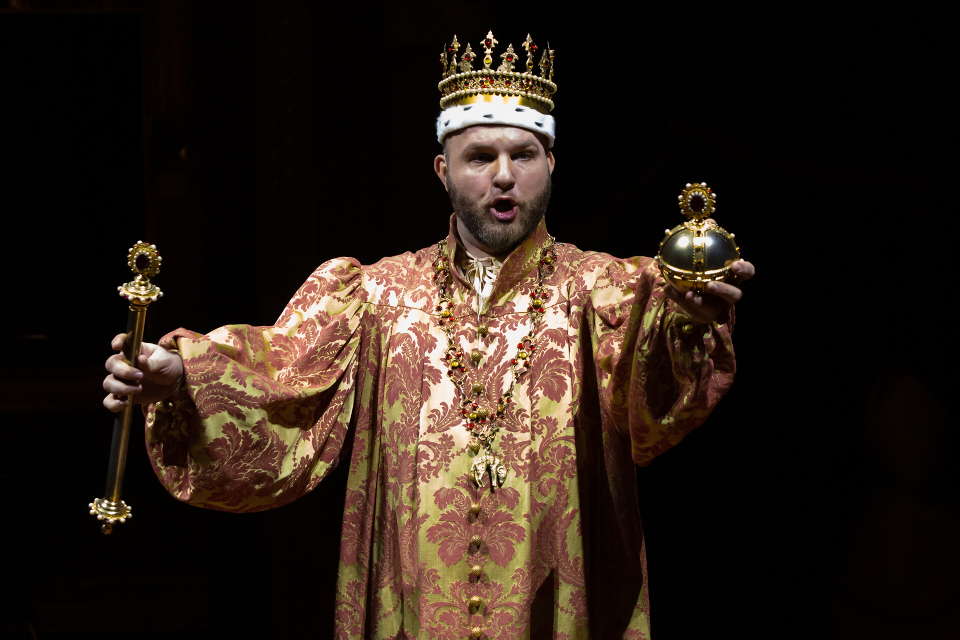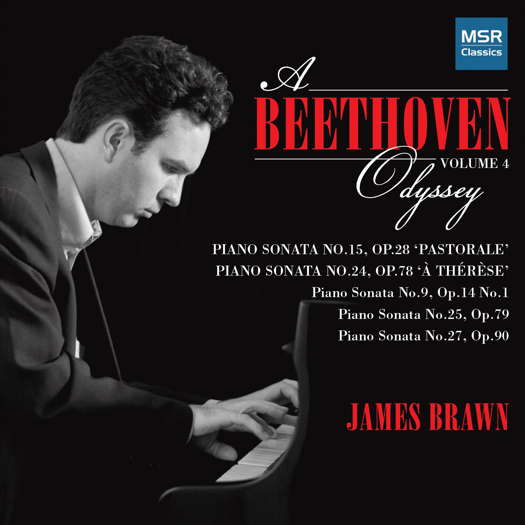 SPONSORED: An Outstanding Evening - Bill Newman listens to American pianist Rorianne Schrade.
SPONSORED: An Outstanding Evening - Bill Newman listens to American pianist Rorianne Schrade.
All sponsored features >>
A Revolutionary 'Ernani' in Palermo
GIUSEPPE PENNISI reports on a production modified for TV and streaming
Ernani, Verdi's fifth opera, is not performed often, mostly because it requires four great singers: a dramatic coloratura soprano, a soaring tenor, a soft baritone and a very deep bass. It calls for complicated sets: forests and castles in various parts of sixteenth century Spain, the tomb of Charlemagne (as well as the Cathedral) in Aachen, and even a wedding dance on a terrace overseeing Aragon. I have reported only twice on Ernani in this magazine's predecessor - Intense Confrontation on 15 May 2011 and Intergenerational Conflict on 4 December 2013. The former was the revival in Bologna of a successful production that had its debut in Palermo in 1999; I had seen it in Palermo Teatro Massimo, was enthralled by it and travelled to Bologna Teatro Comunale to see it again. The latter was the inauguration of the 2013-2014 Rome Teatro dell'Opera season with Riccardo Muti in the pit; that season was dedicated to Verdi and Wagner birth bicentennials. Both productions are relevant to the Palermo Teatro Massimo staging that opened on TV on 26 February 2021 and can be seen and heard on the theater's website.
First of all, this is not a mere revival of the 1999 staging. As purported in this magazine on 6 February 2021, not all productions are fit for TV or for streaming. The 1999 Ernani production was revamped by two TV specialists, Gery Palazzotto and Antonio Di Giovanni. The set and costume designer Francesco Zito and his collaborators Andrea Fiduccia and Fabiola Nicoletti kept the sumptuous attire but modified the sets. Giuseppe Di Iorio provided new lighting. The overall mise en espace was the responsibility of Ludovico Rajata. In short, the orchestra was with adequate spacing, from the stage to about half of the stalls section; the action developed in the other half of the section with a few props and special attention to TV requirements; the chorus members were in the four tiers of boxes. Splendid painted drops were the sets shown in the limelight of the stage. I enjoyed the vision tremendously.

A scene from Verdi's Ernani in Palermo. Photo © 2021 Rosellina Garbo
When he composed the opera, Verdi's veins burned with revolutionary flame. His rebellion was against the religion of his fathers and forefathers because God Almighty had let his wife and his children die in a very short time span. His revolt was also against the establishment which did not appreciate at all his out-of-wedlock relationship with soprano Giuseppina Strepponi (who later became his wife). Verdi was not against the Austro-Hungarian domination of a good part of Northern Italy. Indeed, the opera had been commissioned for a fabulous fee - 12,000 Austrian lire - by the Venetian Theatre La Fenice. The subject was meant to be revolutionary right from the beginning. Verdi and Francesco Maria Piave, author of the libretto, had toyed extensively with the idea of an opera on Cromwell, after a Walter Scott novel. They finally turned to Victor Hugo's Hernani which, ten years earlier, had been French Romanticism's flag against traditional Neo-Classical theatre.
The protagonist, Ernani, is a nobleman who has become a bandit not because he aims at some national unity of Spain in the sixteenth century but because he wanted his territories to secede from Spain and from the rest of the Holy Roman Empire. As a matter of fact, his adversaries are Don Carlo, King of Spain, about to became Emperor of the entire Holy Roman Empire (as he does in the third act, set in Aachen) and the Spanish Grandee Don Ruy Gomez de Silva. To make things more complicated, should there have been any need, both Don Carlo and Don Ruy are attracted by Ernani's woman, Elvira. This mix of politics, power, passion and rebellion is such that Verdi took great care in the preparation of the libretto.
As clearly shown by Verdi's published correspondence and analyzed in a brilliant essay by musicologist Daniele Spini, Verdi fought hard (and won) to have the role of Ernani set for a tenor not for an alto (according to the custom of the time). Ernani is the first 'Verdian tenor' with a very clear timbre, a special phrasing and melodious arias to mold the nineteenth century melodrama. Thus, also, the score was, in 1844, revolutionary, even though it is largely made of forme chiuse or 'numbers', which could even be published separately and used for chamber music concerts - often in aristocratic palaces. There is, however, a major departure from the operatic conventions of the time: the customary brilliant rondo for the prima donna is replaced by an extended trio lasting almost half an hour. Ernani quickly became immensely popular. Verdi also revised it, by adding an aria with chorus at the request of nobody less than Gioacchino Rossini, as well as a cabaletta.
Secondly, as Riccardo Muti often pointed out, in Ernani a good conductor can sense and make the audience feel the germs of Verdi's future masterpieces: first Il Trovatore but also Don Carlo, Simon Boccanegra and even Otello. Teatro Massimo's music director, Omer Meir Wellber, was the conductor and brought to this very good orchestra both the revolutionary fever and the premonitions of future masterpieces. The chorus, prepared by Ciro Visco, was of very high standard and deserves a special mention, especially for 'Si Ridesti il Leon di Castiglia'.

The chorus for Ernani in Palermo. Photo © 2021 Rosellina Garbo
The staging concentrates on personal conflicts, carefully controlling the complex sequence of actions necessary to bring characters into confrontation. This allows - another of Verdi's innovations in Ernani - for the solo arias and duets to be easily expanded, and for gathering a sense of real musical drama. Omer Meir Wellber gave strength to the musical drama by enhancing the control over the dynamic of each entire Act, not of the individual musical numbers. Right from the short prelude, he sets forth all the musical ideas featuring the two main dramatic issues of the opera: the solo trumpet and trombone theme - Ernani's fatal oath to Don Ruy - and the lyrical theme capturing Ernani and Elvira's love.
Elvira was one of Dame Joan Sutherland's favorite roles. Eleonora Buratto took up the task. It is the first time she had the taxing role in a fully staged production. I felt she was at ease from the andantino of the cavatina 'Ernani Involami' and all the ornamental vocalizing that follows it.

Eleonora Buratto as Elvira in Verdi's Ernani in Palermo. Photo © 2021 Rosellina Garbo
She exploded in all her vocal abilities in the finale, when her duet with Ernani (Giorgio Berrugi) becomes a trio with Don Ruy (Michele Pertusi), a real profusion of melodic ideas where the lyricism of Buratto and Berrugi is confronted with the grave dissonance of Pertusi. A magnificent conclusion.
Berrugi was debuting in the role. He had the right pitch, from the cavatina in double aria format on to the second act andante of jealousy, until 'Ferma, Crudel, Estinguere' in the last act.

Giorgio Berrugi in the title role of Verdi's Ernani in Palermo. Photo © 2021 Rosellina Garbo
Instead, Pertusi had his debut in the role thirty seven years ago in Modena. Thus, he is a veteran of the Don Ruy role; with age, his high notes are not as pure as they used to be, but he makes up with his deep tonalities as well as with devilish acting whereby his Don Ruy is a grandfather of Otello's Jago. Simone Piazzola is a very experienced baritone: he excelled in 'O' De' Verd'anni Miei', the third act aria which is the turning point of the drama; in this aria he was able to express the extreme change of atmosphere - from somber musical recollections of a florid baritone to new-found strength and broadness of expression.

Simone Piazzola as Don Carlo in Verdi's Ernani in Palermo. Photo © 2021 Rosellina Garbo
Do not miss it.
Copyright © 3 March 2021
Giuseppe Pennisi,
Rome, Italy

FURTHER ARTICLES ABOUT TEATRO MASSIMO
FURTHER ARTICLES ABOUT PALERMO
NINETEENTH CENTURY CLASSICAL MUSIC ARTICLES



